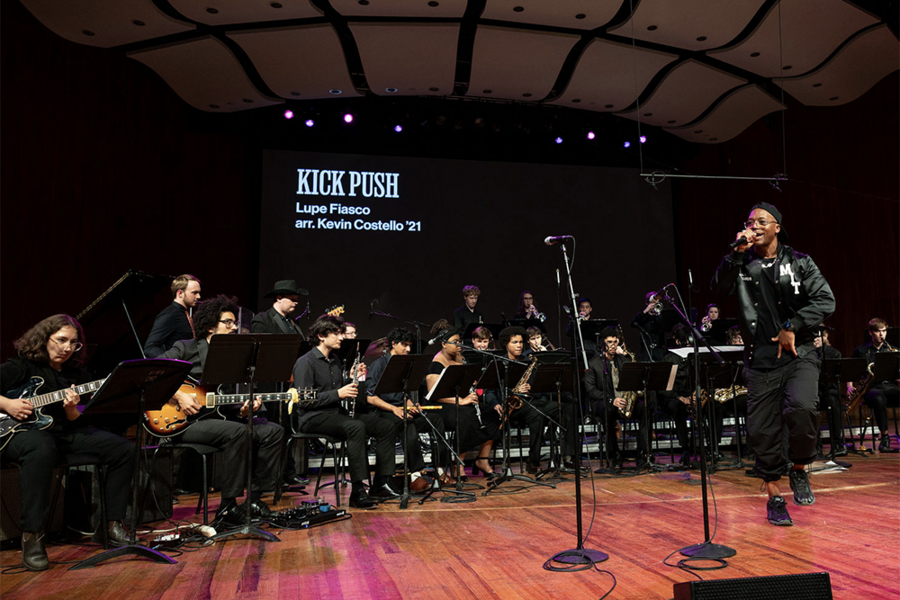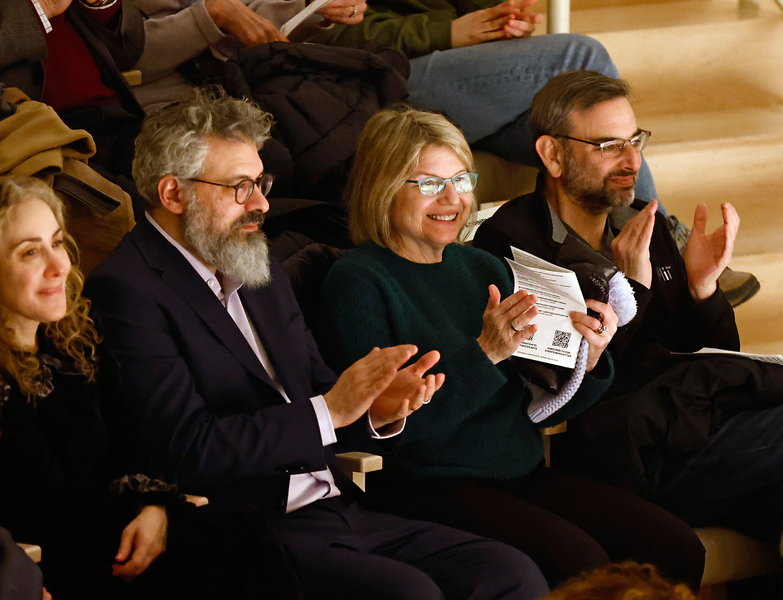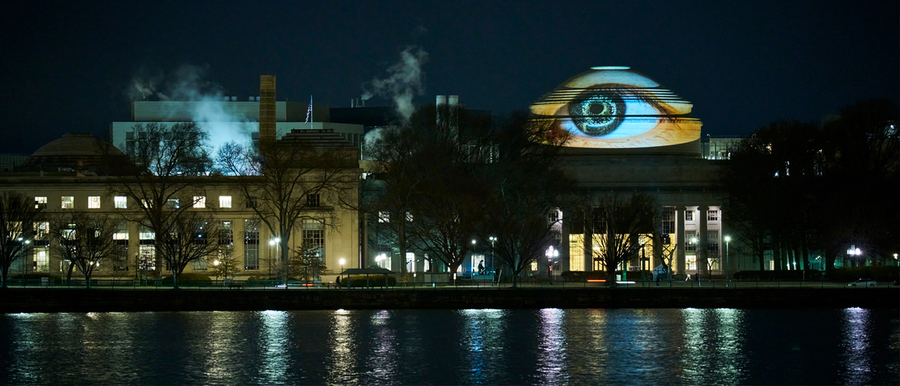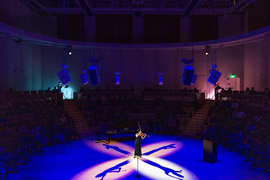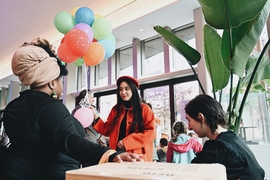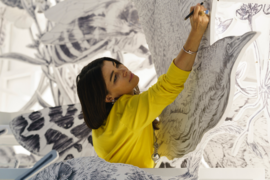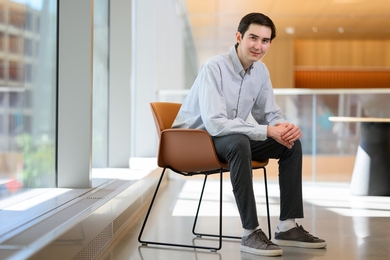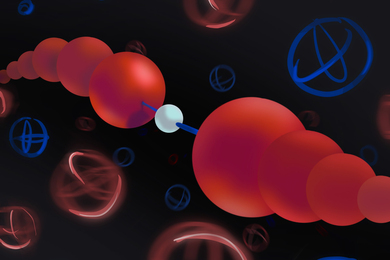When people think of MIT, they may first think of code, circuits, and cutting-edge science. But the school has a rich history of interweaving art, science, and technology in unexpected and innovative ways — and that’s never been more clear than with the Institute’s latest festival, Artfinity: A Celebration of Creativity and Community at MIT.
After an open-call invitation to the MIT community in early 2024, the inaugural Artfinity delivered an extended multi-week exploration of art and ideas, with more than 80 free performing and visual arts events between Feb. 15 and May 2, including a two-day film festival, interactive augmented reality art installations, an evening at the MIT Museum, a simulated lunar landing, and concerts by both student groups and internationally renowned musicians.
“Artfinity was a fantastic celebration of MIT’s creative excellence, offering so many different ways to explore our thriving arts culture,” says MIT president Sally Kornbluth. “It was wonderful to see people from our community getting together with family, friends, and neighbors from Cambridge and Boston to experience the joy of music and the arts.”
Among the highlights were a talk by Tony-winning scenic designer Es Devlin, a concert by Grammy-winning rapper and visiting scholar Lupe Fiasco, and a series of events commemorating the opening of the Edward and Joyce Linde Music Building.
Devlin shared art tied to her recent spring residency at MIT as the latest honoree of the Eugene McDermott Award in the Arts. Working with MIT faculty, students, and staff, she inspired a site-specific installation called “Face to Face,” in which more than 100 community members were paired with strangers to draw each other. In recent years, Devlin has focused her work on fostering interpersonal connection, as in her London multimedia exhibition “Congregation,” in which she drew 50 people displaced from their homelands and documented their stories on video.
Fiasco’s May 2 performance centered around a new project inspired by MIT’s public art collection, developed this year in collaboration with students and faculty as part of his work as a visiting scholar and teaching the class “Rap Theory and Practice.” With the backing of MIT’s Festival Jazz Ensemble, Fiasco presented original compositions based on famed campus sculptures such as Alexander Calder’s La Grande Voile [The Big Sail] and Jaume Plensa’s Alchemist, with members of the MIT Rap Ensemble also jumping on board for many of the pieces. Several students in the ensemble also spearheaded complex multi-instrument arrangements of some of Fiasco’s most popular songs, including “The Show Goes On” and “Kick, Push.”
Artfinity’s programming also encompassed an eclectic mix of concerts commemorating the new Linde Music Building, which features the 390-seat Tull Hall, rehearsal rooms, a recording studio, and a research lab to help support a new music technology graduate program launching this fall. Events included performances of multiple student ensembles, the Boston Symphony Chamber Players, the Boston Chamber Music Society, Sanford Biggers’ group Moonmedicin, and Grammy-winning jazz saxophonist Miguel Zenón, an assistant professor of music at MIT.
“Across campus, from our new concert hall to the Great Dome, in gallery spaces and in classrooms, our community was inspired by the visual and performing arts of the Artfinity festival,” says MIT provost Cynthia Barnhart. “Artfinity has been an incredible celebration and display of the collective creativity and innovative spirit of our community of students, faculty, and staff.”
A handful of other Artfinity pieces also made use of MIT’s iconic architecture, including Creative Lumens and Media Lab professor Behnaz Farahi’s “Gaze to the Stars.” Taking place March 12–14 and coinciding with the total lunar eclipse, the large-scale video projections illuminated a wide range of campus buildings, transforming the exteriors of the new Linde Music Building, the MIT Chapel, the Stratton Student Center, the Zesiger Sports & Fitness Center, and even the Great Dome, which Farahi’s team affixed with images of eyes from the MIT community.
Other popular events included the MIT Museum’s After Dark series and its Argus Installation, which examined the interplay of light and hand-blown glass. A two-day Bartos Theatre film festival featured works by students, staff, and faculty, ranging from shorts to 30-minute productions, and spanning the genres of fiction, nonfiction, animation, and experimental pieces. The Welcome Center also hosted “All Our Relations,” a multimedia celebration of MIT's Indigenous community through song, dance, and story.
An Institute event, Artfinity was organized by the Office of the Arts, and led by professor of art, culture, and technology Azra Akšamija and Institute Professor of Music Marcus A. Thompson. Both professors spoke about the importance of spotlighting the arts and demonstrating a diverse breadth and depth of programming for future iterations of the event.
“People think of MIT as a place you go to only for technology. But, in reality, MIT has always attracted students with broad interests and required them to explore balance in their programs with substantive world-class offerings in the humanities, social sciences, and visual and performing arts,” says Thompson. “We are hoping this festival, Artfinity, will showcase the infinite variety and quality we have been offering and actually doing in the arts for quite some time.”
Professor of music and theater art Jay Scheib sees the mix of art and technology as a way for students to explore other ways for them to approach different research challenges. “In the arts, we tend to look at problems in a different way … framed by ideas of aesthetics, civic discourse, and experience,” says Scheib. “This approach can help students in physics, aerospace design, or artificial intelligence to ask different, yet equally useful, questions.”
An Institute-sponsored campus-wide event organized by the Office of the Arts, Artfinity represents MIT’s largest arts festival since its 150th anniversary in 2011. Akšamija, who is director of MIT’s Art, Culture, and Technology (ACT) program, says that the festival serves as both a student spotlight and an opportunity to interact with, and meaningfully give back to, MIT’s surrounding community in Cambridge and greater Boston.
“What became evident during the planning of this festival was the quantity and quality of art here at MIT, and how much of that work is cutting-edge,” says Akšamija. “We wanted to celebrate the creativity and joyfulness of the brilliant minds on campus [and] to bring joy and beauty to MIT and the surrounding community.”
